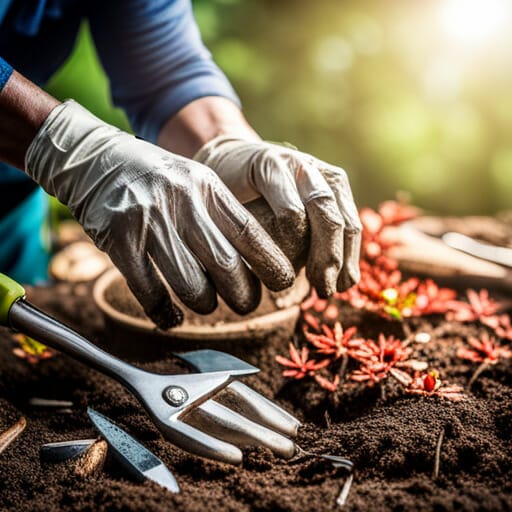In the vast landscape of gardening, the Japanese maple seedling stands as a vibrant jewel, captivating the eye with its delicate leaves and graceful branches. Like a skilled gardener tending to their precious plants, caring for these seedlings requires a delicate touch and a wealth of knowledge.
This article serves as the ultimate guide, providing comprehensive information on how to nurture and cultivate these magnificent trees.
Just as a painter skillfully applies brushstrokes to create a masterpiece, the art of caring for Japanese maple seedlings requires attention to detail and a deep understanding of their unique needs. From selecting the perfect location to repotting and fertilizing, each step plays a vital role in fostering bonsai growth from seeds and ensuring their longevity.
Whether you are a seasoned gardener seeking to expand your knowledge or a novice with a desire to cultivate beauty, this guide will equip you with the essential tools and techniques to care for Japanese maple seedlings. Let us embark on this journey together, as we unravel the secrets and unveil the art of nurturing these enchanting botanical treasures.
Contents
- 1 Quick Points
- 2 How to Care
- 3 Frequently Asked Questions
- 3.1 How long does it take for Japanese maple seedlings to germinate?
- 3.2 Can Japanese maple seedlings tolerate full sun exposure?
- 3.3 What is the ideal temperature range for Japanese maple seedlings?
- 3.4 How often should Japanese maple seedlings be fertilized?
- 3.5 What are some common signs of root rot in Japanese maple seedlings?
Quick Points
- Japanese maple seedlings should be kept in a sunny, well-drained, and well-ventilated place.
- Repotting twice during the first year after germination promotes the development of good surface roots.
- Seedlings should be protected from late afternoon sun in summer to prevent leaf scorch.
– Care should be taken to water the seedlings properly, avoiding both overwatering and underwatering.
How to Care

Caring for Japanese maple seedlings involves keeping them in a well-drained and well-ventilated outdoor location.
Watering them when the soil is partially dried and repotting them twice in the first year after germination to encourage the growth of healthy surface roots.
It is important to thin out seedlings that are not growing well or are deformed, as this improves airflow and lighting.
To prevent leaf scorch, it is advisable to avoid exposing the seedlings to late afternoon sun during the summer. If necessary, they should be moved under shade or covered with a sheer cloth in the afternoon.
Additionally, providing enough space between pots is essential to allow proper air circulation. In frost regions, burying the pots in the ground helps prevent freezing.
Proper watering is crucial, as both lack of water and overwatering can damage the roots and lead to root rot.
It is recommended to use a soil mix that includes akadama, river/lava rock, and organic compost, and to repot the seedlings using clay pots or shallow containers with good drainage and aeration.
Pruning roots that grow straight downward during repotting is necessary to promote the development of healthy surface roots.
When repotting, each seedling should be planted straight up in the soil and given plenty of water after the process.
Fertilizing should be done with a diluted liquid fertilizer after the first repotting, and it should be resumed once it gets cooler and stopped before leaves turn color.
Although relatively insusceptible to pests and diseases, Japanese maple seedlings may occasionally encounter aphids, which can be eliminated with a common pesticide.
##

Watering is an essential aspect of the maintenance of Japanese maple seedlings. It is important to ensure that the soil is adequately moist but not overly saturated. Proper watering is crucial for the health and development of these seedlings. It is recommended to water them thoroughly whenever the surface of the soil appears dry.
However, it is important to avoid overwatering, as it can lead to root rot. On the other hand, lack of water can also be detrimental to the roots and cause damage. Therefore, it is necessary to strike a balance and water the seedlings when the soil is half dry.
By providing adequate moisture, the seedlings can thrive and develop strong roots, which are essential for their overall growth and survival.
Learn Ultimate Guide To Growing Bonsai From Seeds
##

Proper maintenance of Japanese maple seedlings includes repotting them twice during the first year to promote the development of good surface roots. This practice is essential for ensuring the healthy growth and long-term survival of the seedlings.
Repotting should be done one month after germination and again in early fall or early March the following year. During repotting, roots that grow straight downward should be pruned to encourage the growth of surface roots.
It is important to use a soil mix that consists of akadama, river/lava rock, and organic compost, as this combination provides the necessary nutrients and drainage for the seedlings. Additionally, clay pots or shallow containers with good drainage and aeration should be used for repotting.
After repotting, the seedlings should be given plenty of water and placed in half shade for 2-3 days to promote root growth.
Overall, following these repotting guidelines will help ensure the successful cultivation of Japanese maple seedlings.
You Might Also Be Interested Choosing A Healthy And Stylish Japanese Maple Bonsai
Frequently Asked Questions
How long does it take for Japanese maple seedlings to germinate?
Japanese maple seedlings typically take about 1 to 3 months to germinate. The germination time can vary depending on factors such as temperature, moisture, and seed quality.
Can Japanese maple seedlings tolerate full sun exposure?
Japanese maple seedlings can tolerate full sun exposure to some extent, but they should be protected from intense afternoon sun during the summer to prevent leaf scorch. Providing shade or covering with a sheer cloth in the afternoon is recommended.
What is the ideal temperature range for Japanese maple seedlings?
The ideal temperature range for Japanese maple seedlings is between 50°F to 75°F (10°C to 24°C). This range provides optimal conditions for their growth and development, ensuring they thrive in a suitable environment.
How often should Japanese maple seedlings be fertilized?
Japanese maple seedlings should be fertilized once to twice a month until summer to support fine root and branch growth. Fertilization should be resumed when it gets cooler and stopped before leaves turn color.
What are some common signs of root rot in Japanese maple seedlings?
Common signs of root rot in Japanese maple seedlings include wilting or yellowing leaves, stunted growth, and a foul odor coming from the soil. The roots may appear dark, mushy, or rotting. Proper watering and well-draining soil can help prevent root rot.




